As electric vehicles (EVs) build market share across the United States, it will be increasingly important to balance the rising demand for charging services at times when the grid has excess capacity, reducing the total costs for grid services instead of increasing them. Bidirectional charging through vehicle-to-grid (V2G) technology has the capability to deploy demand-response actions to ease concerns, however, and add resilience benefits while decarbonizing emergency generation.
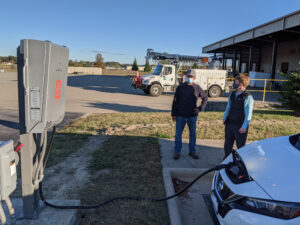 Findings from a two-year demonstration of a V2G technology in North Carolina show the positive economic potential for using bidirectional charging technologies to feed energy stored in electric vehicle batteries back to charging sites, especially when the grid is experiencing high demand. The NC Clean Energy Technology Center (NCCETC) along with Advanced Energy, Enpira, Clean Energy Works, and the Environmental Defense Fund observed this powerful demonstration of a bidirectional charger and software platform from Fermata Energy.
Findings from a two-year demonstration of a V2G technology in North Carolina show the positive economic potential for using bidirectional charging technologies to feed energy stored in electric vehicle batteries back to charging sites, especially when the grid is experiencing high demand. The NC Clean Energy Technology Center (NCCETC) along with Advanced Energy, Enpira, Clean Energy Works, and the Environmental Defense Fund observed this powerful demonstration of a bidirectional charger and software platform from Fermata Energy.
Roanoke Electric Cooperative’s (REC) headquarters in the rural town of Ahoskie, North Carolina, served as the test site for Fermata Energy’s FE-15 bidirectional charger along with the cooperativ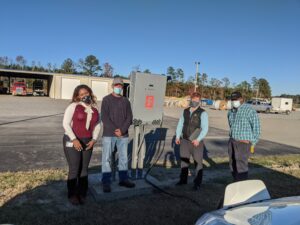 e’s two Nissan LEAF Plus cars. The Nissan LEAF has led the way in the fully electric passenger vehicle market that is capable of vehicle-to-grid technologies in the United States. The market has since grown with the vehicle-to-building capable F-150 Lightning, the Hyundai IONIQ, and the Kia EV6 expanding the development of V2X technologies.
e’s two Nissan LEAF Plus cars. The Nissan LEAF has led the way in the fully electric passenger vehicle market that is capable of vehicle-to-grid technologies in the United States. The market has since grown with the vehicle-to-building capable F-150 Lightning, the Hyundai IONIQ, and the Kia EV6 expanding the development of V2X technologies.
NCCETC Clean Transportation Specialist, John Bonitz said, “We’re honored to be involved in pilot programs like this demonstration at Roanoke Electric Cooperative that can help make fleet electrification more economically viable by proving the value of integrating V2B and V2G technology to shave peaks, improve grid optimization and increase resilience — all while helping the cooperative and its members save money.”
Quantifying the potential value streams from bidirectional charging allows utilities to begin considering incentive payments and other EV program options for customers and members. By demonstrating significant positive value, this study encourages utilities in similar market conditions to help customers overcome the financial barriers to purchasing an EV, particularly in low- and moderate-income areas where these costs may restrict EV adoption. Roanoke is also considering a demand response program to incentivize EV growth and use the storage capacity to reduce peak demand and other charges while at the same time helping to make the transition to EVs more affordable for customers.
A bidirectional EV can receive energy (charge) from electric vehicle supply equipment (EVSE) such as the FE-15 and provide energy to an external load (discharge) when it is paired with a similarly capable EVSE. “Bidirectional chargers, simply put, can unlock new value streams by enabling energy to go into the car’s batteries or, when needed, can discharge energy back into the grid, a building, a house, or any electrical load,” explained John Bonitz. EV owners can use bidirectional charging to save money with their local electric utility, thus reducing the total cost of ownership of the vehicle.
With only vehicle-to-building use cases, REC demonstrated monthly gross savings that exceed the monthly lease cost for its EVs. Use of the bidirectional EVs as mobile battery storage reduced behind-the-meter electricity costs through three use cases: peak load reduction and load following, backup generator support while the building was islanded from the grid, and coincident peak demand reduction.
Peak load reduction shrinks the cooperative’s building’s monthly demand from the electrical grid, which can generally decrease the facility’s electric bill; load following adjusts the power output from an EV’s batteries as the building’s load increases and decreases; and coincident peak demand is when the cooperative’s peak coincides with the overall grid-system’s peak, thus helping both the electric cooperative, the local region and its customers by minimizing pollution generating sources while reducing electric service costs for all member-owners.
Smart charging and discharging solutions with V2X can be programmed to meet the fleet operator’s needs. V2G systems can schedule responses to system-wide peak demand events in advance, so a fleet manager can choose to reserve the vehicle for the grid (or building) at that time while leaving the vehicle plugged in. After the bidirectional event, the V2G system allows scheduled recharging to be programmed to meet fleet needs while providing transparency on the monetary value the vehicle can provide at different times for grid operations. Alternatively, the fleet manager or vehicle operator can choose a program to prioritize the readiness of the vehicle for transportation first, and grid-support services second.
Fermata Energy’s FE-15 can provide 15 kilowatts (kW) of power to the car and back to the site served by the grid. REC schedules dispatch of the onboard battery in response to predicted peaks, which usually last two to three hours. Using only one of REC’s Nissan LEAFs, the bidirectional charging system has been able to reduce the cooperative’s load and lower system-wide peak demand charges in 11 out of 22 months – every time the peak window was successfully predicted and communicated by the energy suppliers.
In addition to system-wide peak demand response, bidirectional charging can be used for demand charge management for building peak load reduction and load following. Despite having relatively modest demand charges of $9.50/kW, Fermata Energy’s software and charger strategically dispatched the Nissan LEAF battery to reduce REC’s headquarters’ building demand charges, resulting in savings in 16 out of 24 months.
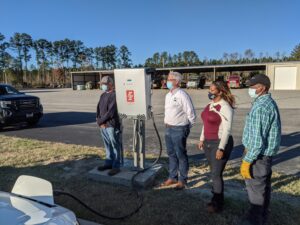
“The combined value streams produced gross savings for REC of more than $3,200 per year, per charger – that’s greater than the lease cost of the EV,” Bonitz said. “The value of this single unit hints at the broader potential for much greater savings when multiplied by many units, serving multiple EVs or even integrated across an entire fleet of EVs.” He further clarified these savings would be in addition to the lower operating costs and fuel savings that have long been demonstrated by electric fleet vehicles.
Both public and private fleets in the United States are looking into viable strategies to transition away from internal-combustion engine vehicles and replace them with EVs. V2G technology can ensure that EVs are charged and ready for driving, secure on-time departure, and reduce total costs of ownership by generating additional revenue for owners.
Vehicle-to-building (V2B) technology could also keep the power on for critical services, such as hospitals and shelters, during extreme weather conditions and other emergency outages, reducing or even eliminating the cumulative number of hours these essential systems have to use backup diesel generators.
The Electrification Coalition’s new guide, “V2X Implementation Guide and Mutual Aid Agreement Template for Using Vehicle-to-Everything-Enabled Electric School Buses as Mobile Power Units to Enhance Resilience During Emergencies” describes the potential to use V2X-enabled electric school buses (ESBs) as alternative emergency backup power sources during outages. The adoption of ESBs is rising as school districts and fleet operators become aware of the significant benefits: clear air for student passengers, savings on bus fuel and maintenance costs, and reduced carbon emissions. ESBs are also gaining attention for their potential to enhance critical electric infrastructure resilience and reliability. Click here to learn more about this resource and how utilizing ESBs to power critical facilities in emergencies can enhance infrastructure resilience, save lives, and strengthen our energy and national security.
On a residential scale, EV owners could use vehicle-to-home (V2H) technology to power their homes during lengthy blackouts. With a bidirectional charging system, homeowners could pull power from their vehicle’s batteries to keep fridges, lights, and heating and cooling systems on in their homes.
Bonitz said, “We’re honored to be involved in pilot programs like this demonstration at Roanoke Electric Cooperative that can help make fleet electrification more economically viable by proving the value of integrating V2G technology to shave peaks, improve grid optimization and increase resilience – all while helping the cooperative and its members save money.”
Quantifying the potential value streams from bidirectional charging allows utilities to begin considering incentive payments and other EV program options for customers and members. By demonstrating significant positive value, this study encourages utilities in similar market conditions to help customers overcome the financial barriers to purchasing an EV, particularly in low- and moderate-income areas where higher EV costs slow their adoption. As the pilot program continues at Roanoke Electric, management is considering a demand response program to expand numbers of EVs by using these bidirectional value streams to help make the transition to EVs more affordable for their member-owners.
NCCETC and Advanced Energy are now sharing these lessons learned with interested parties across NC and beyond. Other cooperative utilities are intrigued to learn of ways that these EV charging infrastructure investments can help pay for themselves while reducing overall costs for their member-owners.

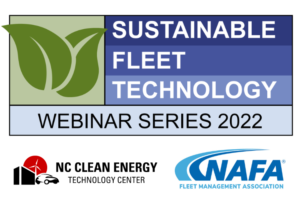
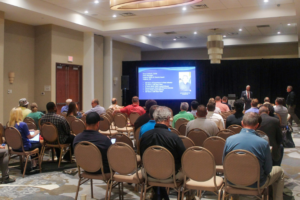
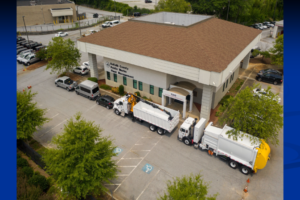
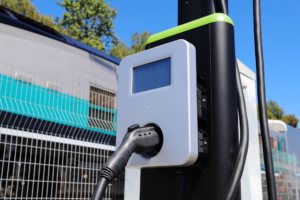
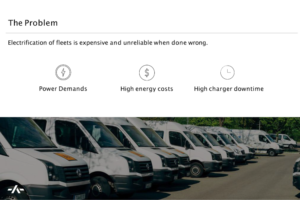
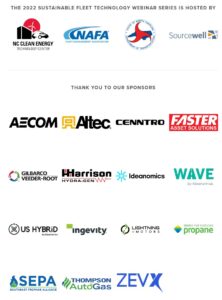
 Electr
Electr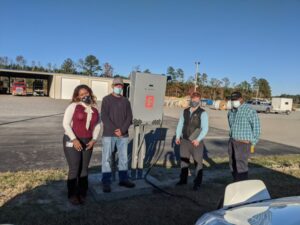 The
The